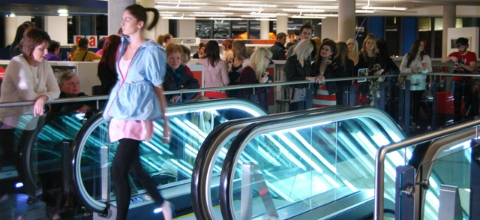Fashion shows, silent discos, speed dating and stand-up comedy. This is the face of the modern library in Cardiff
As you enter the towering six-storey glass building through the revolving doors, the sound of a teenager playing scales on a grand white piano greets you while children run around screaming at the top of their voices. Take the escalator to the next floor, and a street dance workshop begins. This is one of Wales’s most popular cultural venues; the public library.
While library use dives in England and Scotland, statistics reveal a different picture this side of the border. So as the rest of Britain falls out of love with its libraries, how has Wales reversed the trend?
In the last decade, both the Welsh Government and Cardiff Council have endeavoured to reestablish libraries as integral to the communities they serve. Since the Government announced its Libraries for Life programme in 2008 to improve library and information services in Wales, 68 libraries in the area have benefitted. With a further £10m investment in Welsh libraries announced earlier this year, it seems the country will be turning the page to bigger and better things.
Recent statistics show that library visits in Wales are up by 5.4% while England and Scotland have witnessed a decline. These figures have been welcomed by Delyth Humphreys, head of Reading Promotion at the Welsh Books Council, at a time when libraries outside of Cardiff are facing the threat of closure as local councils consider budget cuts.
Over the years, Delyth has organised a number of schemes to encourage reading in families across the country. She believes libraries now play an increasing role in the local community. She says, “With the economic constraints, the need for libraries is greater than ever before.”
Community central
The status Cardiff Central Library has enjoyed this year has pushed it to overtake Swansea to claim the title as Wales’s most popular library, according to statistics released last month from the Chartered Institute of Public Finance and Accountancy.
Opened in 2009 by the Manic Street Preachers and costing £13.5 million to build, it was obvious the building wouldn’t be another lobby of silence. Development officer for Cardiff Libraries, Laura Wood says that in the past, libraries failed to engage with their users. She recalls, “They tended to be warehouses for information, rather than gateways for information.”
Two years on, the library boasts a back catalogue of events from the likes of psychic readings, to music gigs including Battle of the Bands. By providing a venue for these functions, Laura says they have attracted users who had never set foot in the library previously. “People are obviously using the libraries but perhaps not in the traditional way,” she says.
Not only are the ways people use libraries different, but also the people who use them. Visitors range from the homeless to the many cultures Cardiff welcomes; both Nicola and Laura view the library as a space of social inclusion. “For people who perhaps don’t have an opportunity to speak to anyone, it’s the only social connection they have,” says Nicola. “That makes a huge difference to people’s lives.”
Turning the page of her events folder like a family album, she smiles at a photo of a young boy laughing. “It’s lovely, it really is. We’re not just about encouraging people to read. We’re about changing people’s lives,” she smiles, acknowledging the cliche. “But seriously, you can make a difference.”
The next chapter
While many express doubts over the future of libraries, Delyth Humphreys says that as they continue to expand the reach of their services, their agenda will remain perennial. “Libraries have not lost any of their remit,” she says. “The format of books has changed but libraries are there to provide a service to the public. Libraries still encourage people to discover reading in a variety of ways.”
You can’t get much more variety if you look at next year’s line-up at Cardiff Central Library, as Nicola and her team prepare for the worlds of burlesque and opera. Even erotic storytelling will take centre stage one night in 2012. She says, “We like to make culture more accessible.”
So how does the library intend on conserving this popularity? Striving towards relevance while maintain welcoming spaces is the key, Nicola says. “We don’t see ourselves as a stuffy institution and we continue to battle against that.”
In the future, Delyth predicts that most libraries will take their lead from Cardiff. “I think libraries will continue to come up with new and innovative ways to draw people in and keep people reading; that’s always been their remit.”
As libraries start to offer much more outside the book, that white grand piano now plays to a whole host of new crowds. What is most remarkable is not the changing face of libraries, but the changing face of its users.

